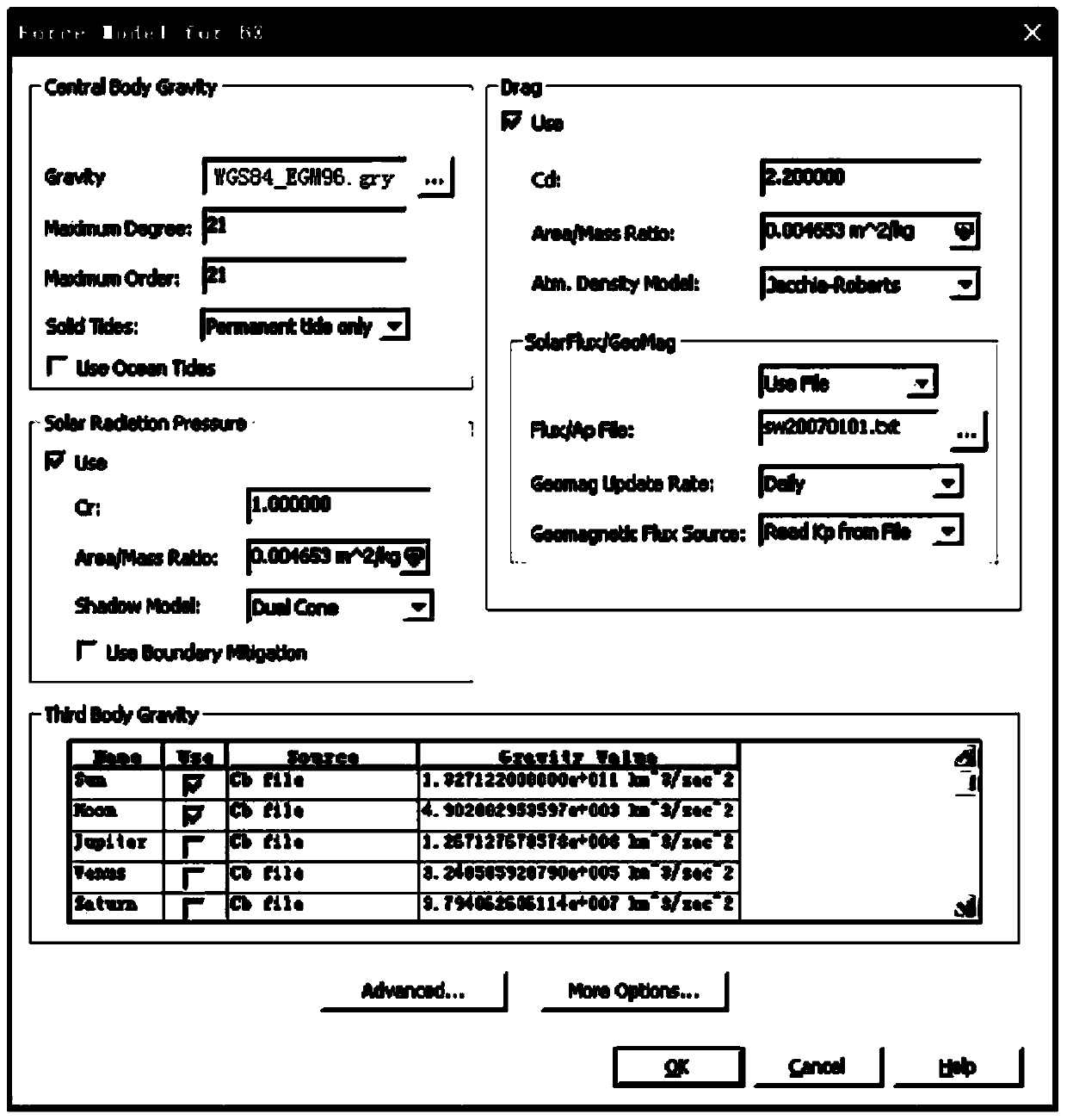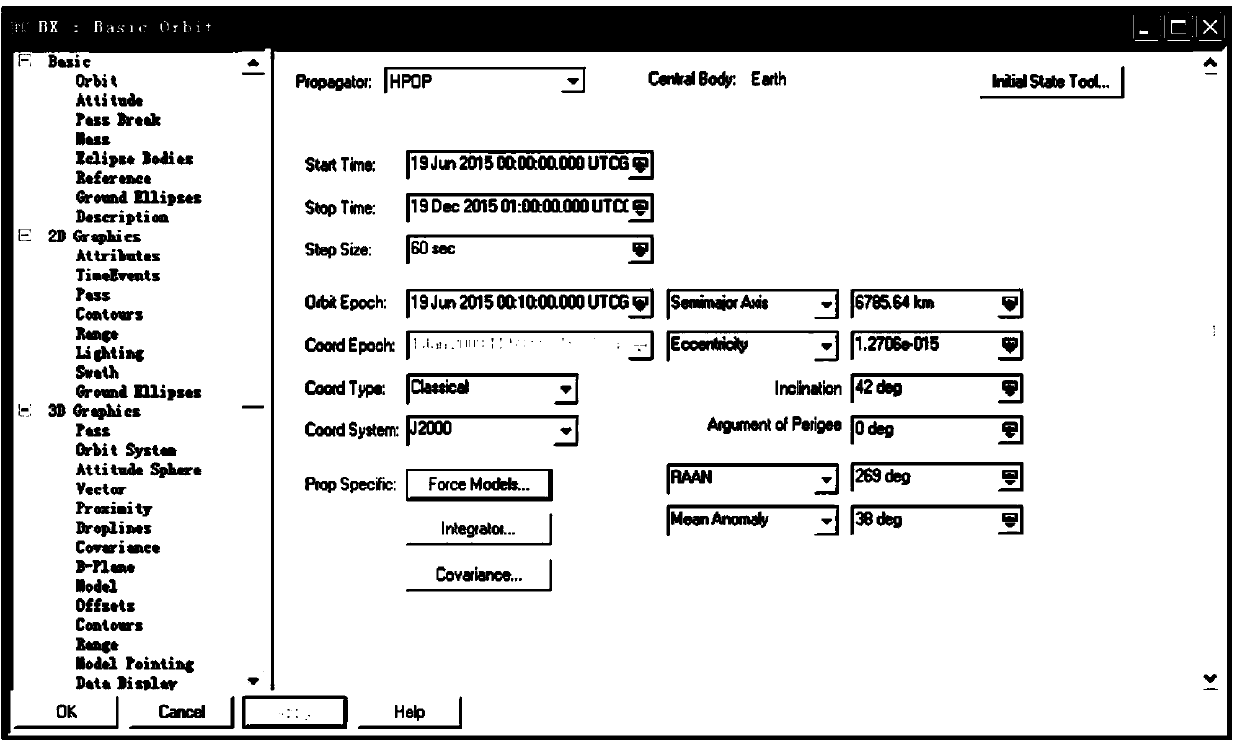On-board autonomous orbit extrapolation method suitable for circular-orbit satellite
A technology of autonomous orbit and push method, applied in the direction of complex mathematical operations, etc., can solve problems such as consuming more hardware resources, high calculation accuracy, and complex calculation models
- Summary
- Abstract
- Description
- Claims
- Application Information
AI Technical Summary
Problems solved by technology
Method used
Image
Examples
Embodiment 1-L
[0090] Example 1 - LEO (Low Orbit) Satellite
[0091] 1. Simulation input
[0092] (1) In this simulation example, the simulation standard data is the simulation data of STK software. For the simulation mechanical model, see figure 2 The mechanical model selected for the simulation shown is the numerical extrapolation method of the "HPOP" model.
[0093] (2) The Jacchia–Roberts model is selected as the atmospheric perturbation model in this simulation example, and the geomagnetic flow index and atmospheric perturbation related parameters provided by the US NASA website are selected by reading files.
[0094] (3) The initial orbital elements of the simulation in this simulation example are as follows image 3 The initial instantaneous radicals of the extrapolation shown.
[0095] (4) For the error of the number of 6 tracks in this simulation example, see Figure 4 Errors of the square roots shown.
[0096] 2. Simulation output
[0097] Simulation results such as Figure...
Embodiment 2-M
[0100] Example 2 - MEO (Medium Orbit) Satellite
[0101] 1. Simulation input
[0102] In this simulation example, the orbit data generated by the HPOP model of the STK software is used as the standard value, and the orbit extrapolation method of this program is used to generate the orbit data, and the difference between the standard value generated by the STK software is used, and the result is the extrapolation accuracy of this method .
[0103] Among them, the simulation input conditions such as Figure 10 The initial orbital elements of the MEO orbital simulation shown and Figure 11 Mechanics model for MEO simulation shown.
[0104] 2. Simulation output
[0105] The simulation results of this simulation example are as follows Figure 12 5-day position-velocity error from single-point extrapolation of the MEO orbit shown.
[0106] 3. Simulation conclusion
[0107] according to Figure 16 The statistical results of the position and velocity errors of MEO orbit and IG...
Embodiment 3-I
[0108] Example 3 - IGSO (Incline Geosynchronous Orbit) Satellite
[0109] 1. Simulation input
[0110] In this simulation example, the simulation input conditions are as follows Figure 13 The IGSO orbital simulation initial orbital radicals and Figure 14 The simulation mechanics model of IGSO is shown.
[0111] 2. Simulation output
[0112] The results of this simulation example are Figure 15 The IGSO orbit shown is a single-point extrapolation of the 5-day position and velocity errors.
[0113] 3. Simulation conclusion
[0114] according to Figure 16 The statistical results of the position and velocity errors of MEO orbit and IGSO orbit extrapolated for 5 days shown above show that in this simulation example, the position accuracy of IGSO orbit extrapolated for 5 days can reach 25.3km, and the velocity accuracy can reach 1.7m / s; If the point is extrapolated for 2.5 days before and after the current time, the position accuracy of IGSO orbit extrapolation for 2.5 day...
PUM
 Login to View More
Login to View More Abstract
Description
Claims
Application Information
 Login to View More
Login to View More - Generate Ideas
- Intellectual Property
- Life Sciences
- Materials
- Tech Scout
- Unparalleled Data Quality
- Higher Quality Content
- 60% Fewer Hallucinations
Browse by: Latest US Patents, China's latest patents, Technical Efficacy Thesaurus, Application Domain, Technology Topic, Popular Technical Reports.
© 2025 PatSnap. All rights reserved.Legal|Privacy policy|Modern Slavery Act Transparency Statement|Sitemap|About US| Contact US: help@patsnap.com



